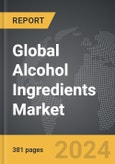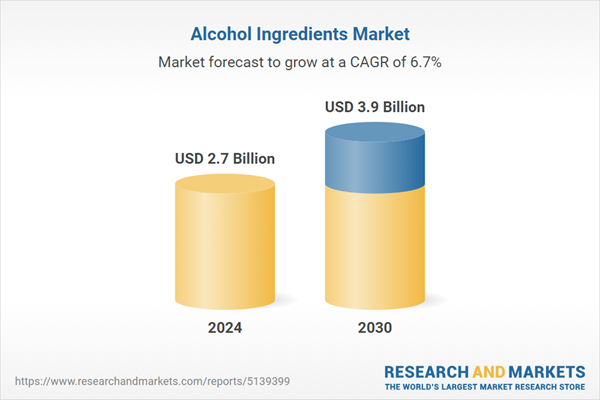The global market for Alcohol Ingredients was valued at US$2.7 Billion in 2024 and is projected to reach US$3.9 Billion by 2030, growing at a CAGR of 6.7% from 2024 to 2030. This comprehensive report provides an in-depth analysis of market trends, drivers, and forecasts, helping you make informed business decisions. The report includes the most recent global tariff developments and how they impact the Alcohol Ingredients market.
Segments: Ingredient Type (Flavors & Salts, Yeast, Colorants, Enzymes, Other Ingredient Types); Beverage Type (Beer, Spirits, Wine, Other Beverage Types).
Geographic Regions/Countries: World; United States; Canada; Japan; China; Europe (France; Germany; Italy; United Kingdom; Spain; Russia; and Rest of Europe); Asia-Pacific (Australia; India; South Korea; and Rest of Asia-Pacific); Latin America (Argentina; Brazil; Mexico; and Rest of Latin America); Middle East (Iran; Israel; Saudi Arabia; United Arab Emirates; and Rest of Middle East); and Africa.
The analysts continuously track trade developments worldwide, drawing insights from leading global economists and over 200 industry and policy institutions, including think tanks, trade organizations, and national economic advisory bodies. This intelligence is integrated into forecasting models to provide timely, data-driven analysis of emerging risks and opportunities.
Global Alcohol Ingredients Market - Key Trends and Drivers Summarized
What Are the Core Ingredients in Alcohol Production?
Alcohol ingredients are the fundamental components used in the production of various alcoholic beverages, including beer, wine, spirits, and liqueurs. The core ingredients typically include water, grains, fruits, sugar, and yeast. Water is the primary ingredient and constitutes the majority of the volume in alcoholic beverages. The quality and source of water can significantly impact the taste and quality of the final product. Grains such as barley, wheat, rye, and corn are essential for making beers and spirits like whiskey and vodka. Fruits, particularly grapes, are crucial for wine production, while other fruits can be used to create flavored spirits and liqueurs. Sugar, whether from grains, fruits, or additional sources like molasses, is vital for fermentation. Yeast is the microorganism responsible for converting sugars into alcohol through the fermentation process, thus playing a pivotal role in determining the alcohol content and flavor profile of the beverage.How Do Different Ingredients Influence the Characteristics of Alcohol?
The choice and quality of ingredients in alcohol production profoundly influence the characteristics of the final product, including its taste, aroma, and appearance. For instance, the type of grain used in brewing beer or distilling spirits can impart distinctive flavors and textures. Barley, for example, is known for producing a rich, malty flavor in beers and whiskeys, while corn can lend a sweeter, smoother taste to bourbon. The variety of grapes and their growing conditions significantly affect the flavor profile, aroma, and complexity of wines. In addition to the main ingredients, adjuncts such as hops in beer production contribute to bitterness, aroma, and preservative qualities. The fermentation process, driven by yeast, not only converts sugars into alcohol but also produces various esters and phenols that add to the beverage's flavor complexity. Aging and maturation processes, particularly in wooden barrels, further enhance the flavor and texture by imparting unique characteristics from the wood and oxidative reactions.What Are the Trends and Innovations in Alcohol Ingredients?
The alcohol industry is continually evolving with new trends and innovations in ingredients and production techniques. One significant trend is the increasing demand for natural and organic ingredients, driven by consumer preferences for cleaner, more sustainable products. Brewers and distillers are exploring the use of ancient grains, heirloom fruits, and locally sourced ingredients to create unique, artisanal products. The rise of craft beverages has spurred innovation in ingredient combinations and production methods, leading to a diverse range of flavors and styles. Additionally, the use of exotic botanicals and spices in gin and other spirits has become popular, offering distinctive and sophisticated flavor profiles. Advances in fermentation technology, such as the use of genetically engineered yeast strains, are enhancing efficiency and allowing for greater control over the fermentation process. These innovations not only improve product quality but also enable producers to experiment with new flavors and create customized alcoholic beverages.What Drives the Growth in the Alcohol Ingredients Market?
The growth in the alcohol ingredients market is driven by several factors, reflecting changes in technology, consumer behavior, and industry practices. One primary driver is the increasing global demand for alcoholic beverages, particularly premium and craft products, which require high-quality ingredients. Technological advancements in agricultural practices and ingredient processing are enhancing the availability and quality of raw materials. The shift towards health-conscious and eco-friendly consumption is propelling the demand for organic and non-GMO ingredients. Additionally, the expanding middle-class population in emerging markets is boosting the consumption of alcoholic beverages, driving the need for diverse and high-quality ingredients. The trend towards personalized and experiential drinking experiences is encouraging producers to innovate with new ingredients and flavor profiles. Regulatory changes and trade agreements are also impacting the market by affecting ingredient sourcing and production practices. Overall, the dynamic interplay of these factors is fostering growth and diversification in the alcohol ingredients market.Report Scope
The report analyzes the Alcohol Ingredients market, presented in terms of units. The analysis covers the key segments and geographic regions outlined below.Segments: Ingredient Type (Flavors & Salts, Yeast, Colorants, Enzymes, Other Ingredient Types); Beverage Type (Beer, Spirits, Wine, Other Beverage Types).
Geographic Regions/Countries: World; United States; Canada; Japan; China; Europe (France; Germany; Italy; United Kingdom; Spain; Russia; and Rest of Europe); Asia-Pacific (Australia; India; South Korea; and Rest of Asia-Pacific); Latin America (Argentina; Brazil; Mexico; and Rest of Latin America); Middle East (Iran; Israel; Saudi Arabia; United Arab Emirates; and Rest of Middle East); and Africa.
Key Insights:
- Market Growth: Understand the significant growth trajectory of the Flavors & Salts segment, which is expected to reach US$1.8 Billion by 2030 with a CAGR of a 7.2%. The Yeast segment is also set to grow at 6.4% CAGR over the analysis period.
- Regional Analysis: Gain insights into the U.S. market, valued at $688.9 Million in 2024, and China, forecasted to grow at an impressive 9.9% CAGR to reach $931.6 Million by 2030. Discover growth trends in other key regions, including Japan, Canada, Germany, and the Asia-Pacific.
Why You Should Buy This Report:
- Detailed Market Analysis: Access a thorough analysis of the Global Alcohol Ingredients Market, covering all major geographic regions and market segments.
- Competitive Insights: Get an overview of the competitive landscape, including the market presence of major players across different geographies.
- Future Trends and Drivers: Understand the key trends and drivers shaping the future of the Global Alcohol Ingredients Market.
- Actionable Insights: Benefit from actionable insights that can help you identify new revenue opportunities and make strategic business decisions.
Key Questions Answered:
- How is the Global Alcohol Ingredients Market expected to evolve by 2030?
- What are the main drivers and restraints affecting the market?
- Which market segments will grow the most over the forecast period?
- How will market shares for different regions and segments change by 2030?
- Who are the leading players in the market, and what are their prospects?
Report Features:
- Comprehensive Market Data: Independent analysis of annual sales and market forecasts in US$ Million from 2024 to 2030.
- In-Depth Regional Analysis: Detailed insights into key markets, including the U.S., China, Japan, Canada, Europe, Asia-Pacific, Latin America, Middle East, and Africa.
- Company Profiles: Coverage of players such as Archer Daniels Midland Company, Ashland, Inc., Cargill, Inc., Chr. Hansen Holdings A/S, D.D. Williamson & Co., Inc. and more.
- Complimentary Updates: Receive free report updates for one year to keep you informed of the latest market developments.
Some of the 158 companies featured in this Alcohol Ingredients market report include:
- Archer Daniels Midland Company
- Ashland, Inc.
- Cargill, Inc.
- Chr. Hansen Holdings A/S
- D.D. Williamson & Co., Inc.
- Dohler GmbH
- Kerry Group PLC
- Koninklijke DSM NV
- Sensient Technologies Corporation
- Treatt Plc
Tariff Impact Analysis: Key Insights for 2025
Global tariff negotiations across 180+ countries are reshaping supply chains, costs, and competitiveness. This report reflects the latest developments as of April 2025 and incorporates forward-looking insights into the market outlook.The analysts continuously track trade developments worldwide, drawing insights from leading global economists and over 200 industry and policy institutions, including think tanks, trade organizations, and national economic advisory bodies. This intelligence is integrated into forecasting models to provide timely, data-driven analysis of emerging risks and opportunities.
What’s Included in This Edition:
- Tariff-adjusted market forecasts by region and segment
- Analysis of cost and supply chain implications by sourcing and trade exposure
- Strategic insights into geographic shifts
Buyers receive a free July 2025 update with:
- Finalized tariff impacts and new trade agreement effects
- Updated projections reflecting global sourcing and cost shifts
- Expanded country-specific coverage across the industry
Table of Contents
I. METHODOLOGYII. EXECUTIVE SUMMARY2. FOCUS ON SELECT PLAYERSIII. MARKET ANALYSISSOUTH KOREAREST OF ASIA-PACIFICARGENTINABRAZILMEXICOREST OF LATIN AMERICAIRANISRAELSAUDI ARABIAUNITED ARAB EMIRATESREST OF MIDDLE EASTIV. COMPETITION
1. MARKET OVERVIEW
3. MARKET TRENDS & DRIVERS
4. GLOBAL MARKET PERSPECTIVE
UNITED STATES
CANADA
JAPAN
CHINA
EUROPE
FRANCE
GERMANY
ITALY
UNITED KINGDOM
SPAIN
RUSSIA
REST OF EUROPE
ASIA-PACIFIC
AUSTRALIA
INDIA
LATIN AMERICA
MIDDLE EAST
AFRICA
Companies Mentioned (Partial List)
A selection of companies mentioned in this report includes, but is not limited to:
- Archer Daniels Midland Company
- Ashland, Inc.
- Cargill, Inc.
- Chr. Hansen Holdings A/S
- D.D. Williamson & Co., Inc.
- Dohler GmbH
- Kerry Group PLC
- Koninklijke DSM NV
- Sensient Technologies Corporation
- Treatt Plc
Table Information
| Report Attribute | Details |
|---|---|
| No. of Pages | 381 |
| Published | April 2025 |
| Forecast Period | 2024 - 2030 |
| Estimated Market Value ( USD | $ 2.7 Billion |
| Forecasted Market Value ( USD | $ 3.9 Billion |
| Compound Annual Growth Rate | 6.7% |
| Regions Covered | Global |









